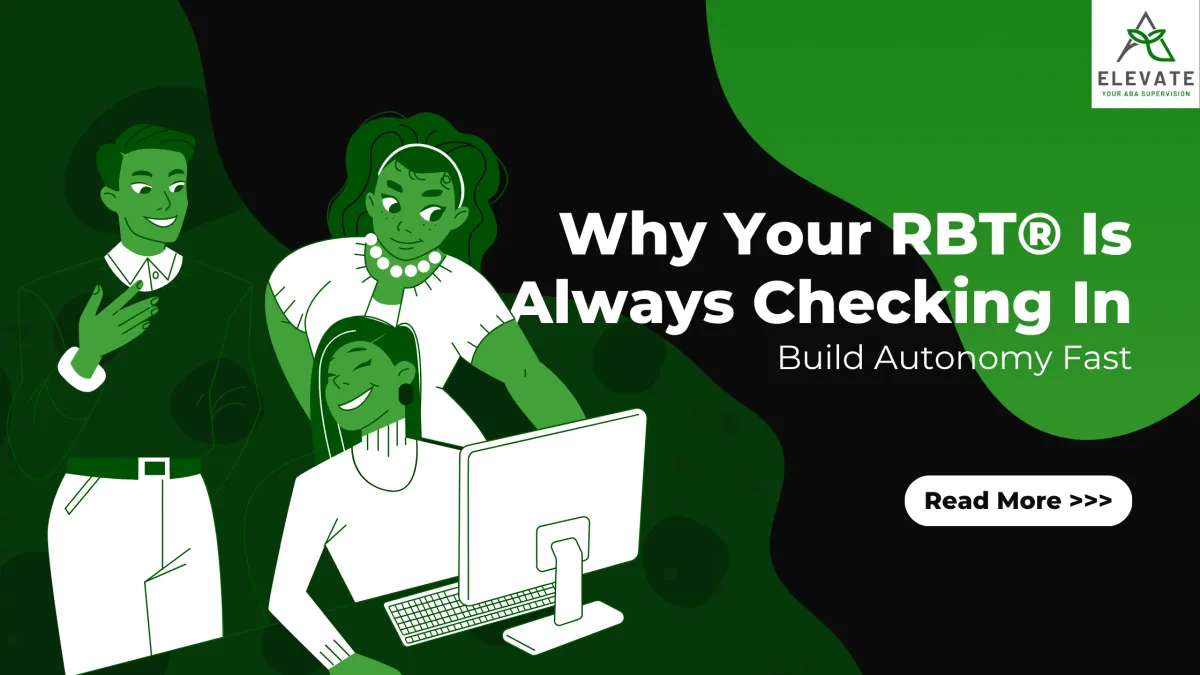
Why Your RBT® Is Always Checking In — And How to Build Independent Thinking
Why Your RBT® Is Always Checking In — And How to Build Independent Thinking
You’re Not Alone — And You’re Not Failing
Autonomy Isn’t Optional—It’s Ethical
The First Step: Assess What You Can’t See
The 4-Step Framework That Builds Independent Thinking
What You Get Inside the CEU Training
✔️ 1.5 BACB® CEUs (1.0 Supervision, 0.5 Ethics)
✔️ Autonomy & Decision-Making Domain from the ASCEND RBT® Assessment System
✔️ Visual tools (decision maps, filters, prompts)
✔️ A 4-step plug-and-play supervision framework
✔️ Real-world examples for multiple settings
"Hey, quick question..."
If you're a BCBA® supervising RBTs®, those three words probably interrupt your day more times than you can count. Whether you’re reviewing data, writing a behavior plan, or on a call with a parent, that little message pops up:
"He’s refusing the puzzle again. Do I switch activities or wait it out?"
It’s not a crisis. But it breaks your focus, delays the session, and slowly erodes your time and energy.
And the worst part? You’ve answered that question before.
You’re Not Alone — And You’re Not Failing
If your RBTs® keep checking in with questions you thought they already knew how to answer, the problem isn’t their memory.
It’s their autonomy.
More specifically, it’s a lack of confidence and clarity about when to act, what’s in their scope, and how to use the behavior plan in real time without constant BCBA® input.
And here’s the truth:
Most RBTs® are trained in what to do, but not in how to think independently.
The RBT® Competency Assessment lays a solid foundation. But it doesn't prepare them for the hundreds of real-world judgment calls they'll make every week.
This leads to:
Constant interruptions for minor decisions
Missed reinforcement windows and session momentum
Supervisor burnout from answering the same scenarios repeatedly
Sound familiar?
Autonomy Isn’t Optional—It’s Ethical
Autonomy doesn’t mean RBTs® work in isolation. It means they:
Make timely, ethical, in-scope decisions
Align their actions with your written behavior plan
Understand when to act independently and when to escalate
And this isn't just good practice. It's part of our ethical responsibility as BCBAs®:
2.01: Providing Effective Treatment
4.06: Supervision and Training
2.15: Minimizing Risk
2.17: Data Use and Decision-Making
If your RBTs® can't act without waiting on your direction, you're more vulnerable to liability, delays in treatment, and even ethical drift.
The First Step: Assess What You Can’t See
Autonomy gaps aren't always obvious—until you're answering your fifth message that week about a minor refusal.
That's why the ASCEND RBT® Assessment System was created. It breaks supervision down into 10 key domains, including a crucial but underdeveloped one: Autonomy & Decision-Making.
This domain helps you pinpoint exactly where RBTs struggle:
Do they hesitate at transitions?
Do they default to asking instead of acting?
Can they respond to low-level behavior without prompting?
Are their decisions aligned with the written plan?
Inside the Decision-Ready RBTs® CEU, you’ll receive access to the Autonomy & Decision-Making Assessment from the full ASCEND RBT® Assessment System—so you can stop guessing and start supervising strategically.
Want the full ASCEND RBT® Assessment System? Explore the complete system here.
The 4-Step Framework That Builds Independent Thinking
The Decision-Ready RBTs® training walks you through a sustainable, evidence-based framework to teach autonomy without adding more to your plate.
Here’s what that looks like:
1. Define Autonomy Clearly
Create operational definitions so RBTs® know exactly what independent action looks like.
Example:
"Initiates prompting hierarchy within 3 seconds of client hesitation, without BCBA® cue."
2. Map the Decision Points
Break down the session into teachable moments:
What happens when the client refuses?
How should the RBT® respond to transition resistance?
When is it appropriate to switch reinforcers?
3. Train in Micro-Bursts
Use real-life BST (Behavior Skills Training) during overlaps and debriefs:
3–5 minute drills
Real-time decision simulations
Verbal practice with quick feedback
4. Support with Tools
Provide decision trees, "If/Then" cards, and ethical filters.
Example: The Ethical Filter Checklist
Is it in the plan?
Is it in my scope?
Is it in the client’s best interest?
Do the data support this action?
If yes = Act.
If no = Escalate.
What You Get Inside the CEU Training
The Decision-Ready RBTs® CEU course includes everything you need to embed autonomy into your current supervision routine—without creating extra work:
✔️ 1.5 BACB® CEUs (1.0 Supervision, 0.5 Ethics)
✔️ Autonomy & Decision-Making Domain from the ASCEND RBT® Assessment System
✔️ Visual tools (decision maps, filters, prompts)
✔️ A 4-step plug-and-play supervision framework
✔️ Real-world examples for multiple settings
Whether you’re working in-home, clinic, or community-based services, this course will give you:
Language to define autonomy
Tools to train it
Metrics to measure it
All while aligning with BACB® supervision and ethics codes.
Final Thought: Firefighting Isn’t Supervision
You didn’t become a BCBA® to spend your day answering minor questions that RBTs® could handle themselves.
With the right framework, you can:
Reduce interruptions
Boost treatment fidelity
Protect your time
Empower your RBTs® to think and act independently
And you can do it without adding more to your supervision load.
👉 Start the CEU Course Today
Build decision-ready RBTs®. Reclaim your time. Elevate your supervision.
#BCBA®Supervision #DecisionReadyRBTs® #EthicalABA #RBT®Skills #AutonomyInABA #BACB®CEU #BehaviorAnalysis #SupervisionStrategy #TrainRBTs® #ABATools #MasterABA #BuildBetterRBTs®
